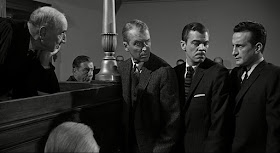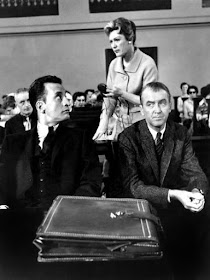 ‘The Criterion Collection’ have recently released a digitally enhanced version of, ‘Anatomy of a Murder’. It was directed by Otto Preminger; it starred James Stewart, Lee Remick, George C. Scott, and Eve Arden; and it lasts for 161-minutes. Plus, as an extra added bonus, the Blu-ray edition comes with the original theatrical trailer, a picture gallery provided by Gjon Mili, newsreel footage from the set, two edited featurettes, as well as interviews with three noted experts, Foster Hirsch, Gary Giddins, and Pat Kirkham. Please enjoy.
‘The Criterion Collection’ have recently released a digitally enhanced version of, ‘Anatomy of a Murder’. It was directed by Otto Preminger; it starred James Stewart, Lee Remick, George C. Scott, and Eve Arden; and it lasts for 161-minutes. Plus, as an extra added bonus, the Blu-ray edition comes with the original theatrical trailer, a picture gallery provided by Gjon Mili, newsreel footage from the set, two edited featurettes, as well as interviews with three noted experts, Foster Hirsch, Gary Giddins, and Pat Kirkham. Please enjoy.Anatomy of a Murder (Criterion Collection)
THE STORY:
Do you know what, Mister McCarthy (Arthur O’Connell)? Ever since you encouraged me to take on this new Manion case, I’ve been trying to figure out if I’ve made the right decision or not. Well, on the one hand, my client, Frederick Manion (Ben Gazzara), has admitted that he deliberately killed the sleazeball who raped his wife, Laura (Lee Remick). While on the other hand, it’s going to be pretty difficult to justify his actions within a court of law. After all, Frederick is a very jealous person, Laura is a very flirtatious lady, and I’m a very apprehensive lawyer, but only because I’m going up against a big-shot prosecutor from Lansing called Claude Dancer (George C. Scott)!
So, what should I do, my old friend? How should I handle this situation? Should I go around town and try to discover new evidence that will help my client’s case? Or should I just shout, scream, and put on a show, when the trial finally begins? Either way, I’m Paul Biegler (James Stewart), lawyer-extraordinaire, and that’s most probably why what next transpires goes, knock-knock-knock, court is now in session. As an argument turns awfully raw – a suspect shows a critical flaw – an attorney deserves a punch in the jaw – and at the end of the day, please remember, innocent or guilty, the law is the law.
THE REVIEW:
Before I start to dissect ‘Anatomy of a Murder’, please allow me to make one thing perfectly clear. This film was based on a true story and shot within the same location the story took place. Namely, within the American state of Michigan. So to some extent, you could safely say this film is more than just your usual 'police procedural' where person A has to defend person B so they can save them from punishment C. In fact, it’s one of the most truthful films I think I’ve seen in a long time, but only because it's slightly ambiguous and partly depends on us, the audience, to rely on our own instincts.
Well, from a narrative point of view, a large portion of the plot revolves around four people who aren’t what they initially seem. For a start, there’s the victim, Bernard Quill, who we never get to see yet is presented as a rapist and a local innkeeper. Next, there’s the accused, Lieutenant Frederick Manion, who’s a gruff looking military man with a mean streak and a jealous temper. After him, there’s his wife, Laura Manion, who was allegedly raped by the victim and comes across as a lonely, scared, and very sensual woman. And last, but certainly not least, there’s the lawyer who’s defending the accused, Paul Biegler. Or as I like to call him, 'Mister Small Town Lawyer' who likes jazz, fishing, and the occasional cigar, but isn’t too keen on looking beyond the truth. A truth, I hasten to add, that makes us think if the accused is truly innocent, the victim is completely guilty, or the lawyer, a mixture of the two.
Now, when it comes down to the film's overall narrative, and more or less, I’d say its structure can be broken down into three unequal parts, with the first 60 minutes dedicated to establishing the characters, the pretext, and the numerous locations; the next 70 minutes alternating between the court case and finding the facts associated with the court case; and finally, the last 30 minutes focused on the conclusion and its inevitable aftermath. So, as you can see, there’s a certain amount of logic behind the construction of this film, and depending on your own personal preferences, it does appear to be longer in length than your conventional courtroom drama. Having said that, though, it doesn’t play out as if it were a long film, no, not really, because each scene has been clearly designed to convey the plot in simple yet incremental stages, which in large part, is complemented by its brave and bold style.
You see, visually speaking, everything we see on screen is nicely framed and allows the audience to concentrate on the plot without being too distracted by any external paraphernalia. Halfway through the film, for instance, we’re presented with a cleverly composed scene where we see Claude (the main prosecutor) cross-examining Laura (the accused’s wife) near the front of the screen, while behind them both, Paul (the lawyer) is seemingly squirming in his chair so he can get a better view of what’s happening before his eyes. Well, that’s what we’re initially led to believe, until Paul complains to the Judge that Claude is deliberately obstructing his point of view, only for Claude to then reply by sarcastically stating, ‘I'm sorry, Mister Biegler. I wouldn't want to interrupt your signals to Ms. Manion’ (all of which, justifies the composition of this scene -- POV -- as well as Claude's sly actions -- to prevent Paul from manipulating the case). There were also a number of other marvelous scenes featured throughout this film which should be noted for their clear direction and artistic merit. But for the sake of time, I think it best that I just say, if you’re a fan of small-town America and everything that goes along with it, such as juke joints, stately courthouses, rustic abodes, and, you know, that sort of thing, then I’m sure you’re going to love this movie’s timely look as well as its jazzy soundtrack (as composed by Duke Ellington).
Anyway, that’s enough of that for the time being, because I think now is a pretty good time for us to sit back, relax, and check out the following filmic facts: (1) ‘Columbia’ first released this eleven million dollar production in Detroit, Michigan, on the exact same day Heinrich Lubke was elected the second president of West Germany. It was on the 1st of July, 1959. (2) The screenplay for this film was adapted from a novel of the same name written by Robert Traver, otherwise known as the Supreme Court Justice of Michigan, John D. Voelker, who based it on a 1952 murder case in which he acted as the defense attorney. (3) Loosely translated, this project was entitled, ‘There is’ in Japan, ‘Peachy Murder’ in Taiwan, and ‘Decomposition of a Murder’ in Belgium. (4) One of the taglines used to promote this picture, states, ‘Last year's No.1 best-seller... This year's No.1 motion picture’. (5) The majority of this movie was shot on location throughout the American state of Michigan. This includes the Marquette County Courthouse, the Bay View Inn, Ishpeming Public Library, the Lumberjack Tavern, the Upper Peninsula, the Tripoli Bar, the Big Bay Inn, Ishpeming Railway Depot, Mount Shasta Lodge, Thunder Bay Inn, Waterfront Lunchstand, Perkins Park Campground & Picnic Area, as well as numerous parts of Michigamme, Big Bay, Ishpeming, and Marquette. (6) During pre-production, a number of different actors were considered for a number of different roles in this drama. This included, Jayne Mansfield and Lana Turner, who were both considered for the part of Laura; Spencer Tracy and Burl Ives, who were both considered for the part of Judge Weaver; Gregory Peck, who was considered for the part of Paul; and Richard Widmark, who was considered for the part of Lieutenant Manion. (7) When James Stewart’s father, Alexander, first saw this film, he deemed it ‘a dirty picture’ because it featured such words as ‘bitch’, ‘contraceptive’, ‘panties’, ‘penetration’, ‘rape’, ‘slut’, and ‘sperm’. In fact, he disliked it so much, he even placed an ad in his local newspaper so he could tell people not to watch it.
In closing my review of ‘Anatomy of a Murder’, I’d now like to rank each key performance in order of preference. So, at the top of my list, I’d like to select the star of the show, James Stewart, because if you can look past his warm and charming temperament, you’ll find that he played Paul Biegler as if he were a fallible man who’s good at his job but not so good at judging the morals of his clients. But if you can’t look past his naturally wholesome temperament? Well, in that case, James Stewart is playing James Stewart, and for that reason and that reason alone, he’s still worth watching nonetheless. Up next, I would like to single out Lee Remick, Arthur O’Connell, and George C. Scott, as they each managed to play a memorable character that stood out from the crowd. Lee did this by playing Laura Manion as a flirtatious lady with a vulnerable side; Arthur, on the other hand, portrayed Parnell Emmett McCarthy as a downtrodden yet lovable sidekick; and finally, George depicted Claude Dancer as a vindictive prosecutor with a predatory nature. Or in other words, they each played characters who showed a lot of character. As for the rest of the cast, though? Well, on the whole, I would say that the only ones really worth mentioning would have to be Ben Gazzara (a.k.a. Frederick Manion) the menacing military man; Eve Arden (a.k.a. Maida Rutledge) the superb secretary; and Kathryn Grant (a.k.a. Mary Pilant) the mysterious Miss; on account of them doing the best with what they had at hand, wink-wink!
So, on that note, all I have left to say is that overall this movie was a marvelous movie because the story was simple, the acting was amazing, and the execution was excellent. But most importantly of them all, it left us asking ourselves one perplexing question: Is the law the same as justice? And if it’s not, what’s the point of obeying a set of rules that hinder more than help? After all, the law is meant to aid society and not allow people to get away with... 💀
Nuff said.
THE RATING: A
ANATOMY OF A MURDER (1959)
 Reviewed by David Andrews
on
March 16, 2020
Rating:
Reviewed by David Andrews
on
March 16, 2020
Rating:
 Reviewed by David Andrews
on
March 16, 2020
Rating:
Reviewed by David Andrews
on
March 16, 2020
Rating:







No comments:
Post a Comment